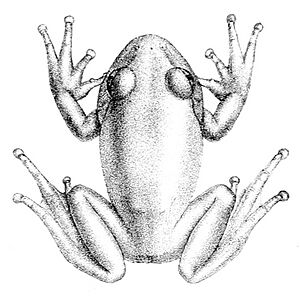Leptopelis viridis facts for kids
Quick facts for kids Leptopelis viridis |
|
|---|---|
 |
|
| Conservation status | |
| Scientific classification | |
| Synonyms | |
|
Hylambates viridis Günther, 1869 "1868" |
The rusty forest treefrog or savannah tree frog (scientific name: Leptopelis viridis) is a type of frog that belongs to the Arthroleptidae family. You can find these frogs across a large area in West and Central Africa. They live in the savanna zones, stretching from countries like Senegal and The Gambia all the way to the northeastern Democratic Republic of Congo.
Where These Frogs Live
The rusty forest treefrog, Leptopelis viridis, lives in many countries across Africa. It has been found in places like Senegal, The Gambia, Guinea-Bissau, Guinea, Sierra Leone, Liberia, Ivory Coast, Burkina Faso, Ghana, Togo, Benin, Niger, Nigeria, Cameroon, and the Democratic Republic of the Congo. Scientists also believe they might live in Mali, Chad, the Central African Republic, Sudan, and South Sudan.
About Their Name
The scientific name Leptopelis viridis was first given to this frog in 1869 by a scientist named Albert Günther. He was a zoologist who studied animals, especially fish and reptiles.
For a while, there was some confusion about this frog's name. Another frog, often called the "Gbanga forest treefrog," was sometimes mistakenly called Leptopelis hyloides. But in 2007, scientists figured out that the original Leptopelis hyloides was actually the same as Leptopelis viridis. The "Gbanga forest treefrog" was then given its own new name: Leptopelis spiritusnoctis. So, if you see older records of Leptopelis hyloides, they are probably talking about Leptopelis spiritusnoctis, not the rusty forest treefrog.
What They Look Like
Male rusty forest treefrogs are about 33 to 35 millimeters long. Females are a bit bigger, measuring about 42 to 48 millimeters. Their backs are smooth and brown, often with darker patterns. These patterns can look like a bar behind their head or an 'n'-shape on their back.
Sometimes, you might even see a green one! The word viridis in their scientific name actually means "green" in Latin. This suggests that the first frog studied might have been green. Male frogs have dark, almost black throats. Their hands do not have webbing, and their feet have only a little bit of webbing.
Their Home and Safety
Leptopelis viridis frogs live in different types of open areas like dry and humid savanna woodlands, shrublands, and grasslands. They are quite tough and can handle changes to their environment.
When it's time to lay eggs, they don't put them directly in the water. Instead, they dig burrows in the ground near temporary savanna ponds. They lay their eggs inside these burrows.
These frogs are very common and live in many protected areas. Because they can adapt well to different places and there are so many of them, scientists believe they are not currently in danger.


